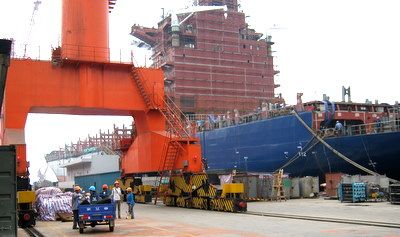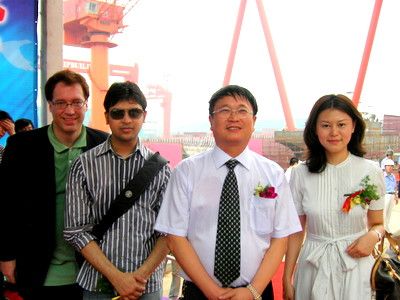

JIANGSU PROVINCE-BASED Yangzijiang Shipbuilding saw its January-March revenue rise 23% year-on-year and 12% sequentially to 2.09 bln yuan.
Over the same period the Singapore-listed shipbuilder’s bottom line rose 30% year-on-year and 22% sequentially to 483 mln yuan.
While these numbers wouldn’t have generated too much excitement in leading-edge Chinese industries earlier this decade, the fact that Yangzijiang was able to produce such stellar results in the midst of one of the most drastic global economic crises in decades is worthy of closer introspection.
A critical factor helping boost both top and bottom lines is a very efficient and effective cost control regime at the company.
“We have the best cost controls (in our industry) in China,” said Yangzijiang’s Executive Chairman, Mr. Ren Yuanlin.
The company also said it bulked up the order book before the downturn to ensure sustainable operations.
Yangzijiang has an impressive order backlog, totaling 145 vessels worth 6.4 bln usd (68 containerships/3.9 bln and 77 bulk carriers/2.5 bln).
And Mr. Ren certainly has a talent for saving (and making) money, as he ranked No.60 on the Forbes 400 Richest Chinese in 2007.

“For each vessel order we receive, it goes through a five-stage process to minimize production costs as much as possible without in any way compromising quality,” he said.
He said that production did not begin until all five stages had been completed.
“At each stage, if we’re under-budget, then great! There will be accolades and rewards. But if we’re over-budget, then we simply won’t move to the next stage until the issues are resolved.”
Mr. Ren, who at last count held 29.23% of the firm’s 3.65 billion total issued shares, was asked by more than one analyst at the day-long meeting and yard tour just how Yangzijiang dealt with one of its most critical input costs – a commodity with a recent history of price volatility – steel.
Indeed, in the first quarter, steel comprised 21% of the company’s production costs, second only to engines and equipment (29%) as an expense category, while labor costs stood at just 10%.
“We, of course, not only want the best quality steel, but also at the best price. We try to enter long-term supply contracts to ensure supply and pricing stability as it’s impossible to know where spot steel prices will be even in the near future,” he said.
He said Sichuan province-based Chongqing Steel was its No.1 supplier, at “good prices and long-term contracts.”


Size catches government eye
In 2008, Yangzijiang was ranked 6th in China and 26th in the world in terms of capacity by delivering 27 vessels totaling up to 850,000 dead weight tones (DWT).
With the group’s order book at 6.9 bln usd, made up of 7.53 mln DWT as at end-2008, Yangzijiang is placed 8th in China and 21st in the world, which elevated it to become one of the few prominent non state-owned ship building enterprises in China to be eligible for the ongoing 4.5 trln yuan stimulus scheme.
On Feb 2, Beijing introduced a stimulus framework for the shipbuilding industry, with a series of proactive measures taken not only to stabilize the landscape for major producers to boost market demand, but also focus on developing the companies’ capabilities to remain competitive and towards restructuring within the market.

And being one of the few shipbuilders in China eligible for the shipbuilding stimulus scheme, Yangzijiang said it will actively liaise with banks to help some ship owners apply for financing to help ensure that contract signing ceremonies eventually turn into boat-launching ceremonies.
Mr. Ren was asked if the shipbuilding side of the economic stimulus – which ostensibly targets SOEs engaged in the trade – would overlook non-state owned operators like Yangzijiang.
“Actually, only military ship orders are off-limits for us under the stimulus tender process. We can also apply for government loans under the scheme, but we don’t actually need them. And Chinese shipbuilders can get credit facilities more easily than foreign shipbuilders,” he said.
The reason Yangzijiang doesn’t need the cash is because its books are in ship-shape.
“We have positive net cash position, with no debt,” Mr. Ren said.
The company plans to continue maintaining a healthy level of cash and cash equivalents on balance with a net cash position in terms of gearing.
Its cash and cash equivalents stood at 3.7 bln yuan at end-March versus 3.1 bln a quarter earlier.
Also, its operating cash flow rose to 531 mln yuan, up from (-822 mln yuan) at end-2008.

“We will only increase capacity if it guarantees a proper level of profit margin. It’s hard to say what an acceptable margin is. It depends. As long as there isn’t a loss, and as long as we have slots (production space) to produce ships, we’ll accept new orders,” he said.
And resting on its laurels it was not. Yangzijiang realized that great shipbuilders needed lebensraum if they hoped to seamlessly adjust output to meet demand spikes.
“Our annual capacity end-year will be 1.8 mln tones, and we will increase this to 2.5 mln by end-2011,” Mr. Ren said.
The new yard will have total capacity of nearly two mln DWT by 2010, while the old yard will stand at around a quarter mln DWT.
Currently the shipbuilder’s new yard in Jiangsu is operating at a capacity utilization rate of about 50%, while the nearby old yard is at full capacity.
Story on a recent visit to another SGX-listed shipyard in China: JES: 'When economy picks up, we'll overperform'
Profile story on Ren Yuanlin: YANGZIJIANG'S chairman eschews the high life






